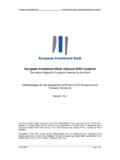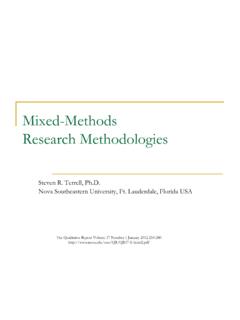Transcription of Basel Committee on Banking Supervision
1 Basel Committee on Banking Supervision Climate-related financial risks measurement methodologies April 2021 This publication is available on the BIS website ( ). Bank for International Settlements 2021. All rights reserved. Brief excerpts may be reproduced or translated provided the source is stated. ISBN 978-92-9259-471-8 (online) Climate-related financial risks measurement methodologies iii Contents .. iv Executive Summary .. 1 1. Introduction .. 4 2. Methodological Considerations .. 6 Conceptual considerations in measuring climate-related financial risks .. 6 Data needs .. 10 The role and characteristics of a micro-prudential climate-risk classification .. 12 Candidate methodologies .. 15 Characteristics of scenario analysis and stress -testing methodologies .. 18 3. Measurement methodologies of climate-related financial risks .. 22 Exposure mapping and measurement.
2 22 Risk quantification: scenario analysis, stress-testing and sensitivity analysis .. 27 4. Areas for future analytical exploration .. 35 Exposure mapping: the challenge of risk differentiation .. 35 Forward-looking assessment methodologies : Accounting for complexity of climate-related financial risks .. 39 5. Conclusion .. 43 References .. 45 Annex: Methodology Comparison .. 49 iv Climate-related financial risks measurement methodologies Glossary Acute physical risk See physical risks Basel Framework The Basel Framework is the full set of standards of the Basel Committee on Banking Supervision (BCBS). As at March 2021 the framework consists of 14 standards as set out at Carbon taxation (carbon tax) A carbon tax (or energy tax) generally refers to a tax levied on the carbon content of some goods and services, typically in the transport and/or energy sectors. The purpose is to reduce CO2 emissions by increasing the price of these goods and services.
3 It is one of the main types of tools used in climate change policies around the world. Chronic physical risk See physical risks Climate Climate in a narrow sense is usually defined as the average weather, or more rigorously, as the statistical description in terms of the mean and variability of relevant quantities over a period of time ranging from months to thousands or millions of years. The classical period for averaging these variables is 30 years, as defined by the World Meteorological Organization. The relevant quantities are most often surface variables such as temperature, precipitation and wind. Climate in a wider sense is the state, including a statistical description, of the climate system. Climate-related financial risks The potential risks that may arise from climate change or from efforts to mitigate climate change, their related impacts and their economic and financial consequences. Climate sensitivity The change in the annual global mean surface temperature in response to a change in the atmospheric CO2 concentration or other radiative forcing.
4 Climate vulnerability Vulnerability is the propensity or predisposition to be adversely affected. It encompasses a variety of concepts and elements including sensitivity or susceptibility to harm and lack of capacity to cope and adapt. In the context of climate risk drivers, vulnerability refers to the level of damage which can be expected at different levels of intensity of a hazard. For example, when a storm surge hits an area with weak building regulations and few flood mitigation measures, it is more vulnerable to loss compared to an area that has strong flood control infrastructure and strong building regulations. Vulnerability assessments may include secondary impacts such as business interruption. Damage functions Relationships translating the effect of a specific hazard or change in global mean temperature affecting a building structure or the real economy into a damage ratio, which is the ratio of the repair cost to its replacement value.
5 Energy label Energy labels describe various levels of energy efficiency, eg of buildings. Energy efficiency refers to the amount of energy required to provide a specific function, product or service (eg heating a building), with the idea that the lower the needed amount happens to be, the more efficiently the function, product or service is provided. ESG ESG (environmental, social and governance) refers to a set of criteria that play a role in the investment decision-making process or in a company s operations. Environmental factors consider how an investment or a company contributes to environmental issues such as climate change and sustainability. Social factors examine the social impacts of an investment or a company on communities. Governance relates to transparency and legal compliance of an investment or a company s operations, for instance in terms of accounting and shareholders rights. Feedback loop An interaction in which a perturbation in one climate quantity causes a change in a second and the change in the second quantity ultimately leads to an additional change in the first.
6 A negative feedback loop is one in which the initial perturbation is weakened by the changes it causes; a positive feedback loop is one in which the initial perturbation is enhanced. The initial perturbation can either be externally forced or arise as part of internal variability. Global mean surface temperature Estimated global average of near-surface air temperatures over land and sea-ice, and sea surface temperatures over ice-free ocean regions, with changes normally expressed as departures from a value over a specified reference period. When estimating changes in global mean surface temperature, near-surface air temperatures over both land and oceans are also used. Climate-related financial risks measurement methodologies v Global warming The estimated increase in global mean surface temperature averaged over a 30-year period, or the 30-year period centred on a particular year or decade, expressed relative to pre-industrial levels unless otherwise specified.
7 For 30-year periods that span past and future years, the current multi-decadal warming trend is assumed to continue. Greenhouse gases (GHGs) Greenhouse gases are those gaseous constituents of the atmosphere, both natural and anthropogenic, that absorb and emit radiation at specific wavelengths within the spectrum of thermal infrared radiation emitted by the Earth s surface, by the atmosphere itself, and by clouds. This property causes the greenhouse effect. Water vapour (H2O), carbon dioxide (CO2), nitrous oxide (N2O), methane (CH4) and ozone (O3) are the primary greenhouse gases in the Earth s atmosphere. Physical hazard (or hazard) The potential occurrence of a natural or human-induced physical event or trend or physical impact that may cause loss of life, injury, or other health impacts, as well as damage and loss to property, infrastructure, livelihoods, service provision, ecosystems, and environmental resources. In TFCR (Task Force on Climate-related Financial Risks) reports, the term hazard refers to climate-related physical events or trends or their physical impacts.
8 Physical risks Economic costs and financial losses resulting from the increasing severity and frequency of: extreme climate change-related weather events (or extreme weather events) such as heatwaves, landslides, floods, wildfires and storms (ie acute physical risks); longer-term gradual shifts of the climate such as changes in precipitation, extreme weather variability, ocean acidification, and rising sea levels and average temperatures (ie chronic physical risks or chronic risks); and indirect effects of climate change such as loss of ecosystem services (eg desertification, water shortage, degradation of soil quality or marine ecology). Physical risk driver Physical risk drivers are the changes in weather and climate mentioned above that lead to physical risks and impacts on economies and banks (eg a flood). Projection A potential future evolution of a quantity or set of quantities, often computed with the aid of a model. Unlike predictions, projections are conditional on assumptions concerning, for example, future socioeconomic and technological developments that may or may not be realised.
9 A climate projection, different from climate predication, is the simulated response of the climate system to a scenario of future emission or concentration of greenhouse gases (GHGs) and aerosols, generally derived using climate models. Representative Concentration Pathway (RCP) Scenarios that include time series of emissions and concentrations of the full suite of GHGs and aerosols and chemically active gases, as well as land use/land cover. The word representative signifies that each RCP provides only one of many possible scenarios that would lead to the specific radiative forcing characteristics. The term pathway emphasises that not only the long-term concentration levels are of interest, but also the trajectory taken over time to reach that outcome. Scenario A plausible description of how the future may develop based on a coherent and internally consistent set of assumptions about key driving forces (eg rate of technological change, prices) and relationships.
10 Scenarios are neither predictions nor forecasts, but are used to provide a view of the implications of developments and actions. Scenario analysis Scenario analysis is a tool that is used to enhance critical strategic thinking. A key feature of the scenarios analysed is to explore alternatives that may significantly alter the basis for business-as-usual assumptions. Accordingly, they need to challenge conventional wisdom about the future. Stranded asset Asset that at some time prior to the end of its economic life is no longer able to earn an economic return as a result of changes associated with the transition to a low-carbon economy (adapted from Carbon Tracker). Stress test The evaluation of a financial institution s financial position under a severe but plausible scenario. The term stress testing is also used to refer to the mechanics of applying specific individual tests and to the wider environment within which the tests are developed, evaluated and used within the decision-making process.


















